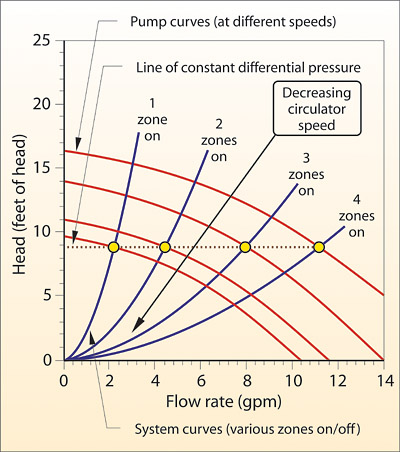
A good example would be a typical multizone system using on/off zone valves for heat delivery control, as shown in Figure 1.
The circulator in such a system is usually sized assuming all zone circuits are operating simultaneously. Under these conditions, the system resistance curve is relatively shallow, as shown in Figure 2.
However, as thermostats are satisfied and zone valves start to close, the system resistance curve gets progressively steeper. When this happens, the operating point shifts upward along the pump curve. Each time another zone valve closes, the remaining zone circuits "feel" an increase in differential pressure. In situations where only one zone circuit is open, the pressure differential may be high enough to create high flow velocities and flow noise. In some cases, the high differential pressure may even cause closed valve plugs to lift partially off their seats.
One way to manage the increase in differential pressure is to install a differential pressure bypass valve (DPBV), as shown in Figure 3.
This valve "truncates" the upper portion of the pump curve above a set differential pressure, as depicted in Figure 4. Notice how the operating points (where the system resistance curves cross over the truncated pump curve) do not move upward any significant amount as the system resistance curves get progressively steeper. This is desirable because it minimizes changes in differential pressure across the other operating zone circuits, and thus helps maintain reasonably stable flow rates.
A differential pressure bypass valve is a "parasitic" device. It controls differential pressure by throttling away excess head energy imparted to the fluid by the circulator. This energy originated as electrical energy input to the circulator motor. Thus, there is an energy cost associated with operation of a differential pressure bypass valve.

The "Ideal" Circulator
A circulator that could operate along a perfectly flat pump curve at some preset head could maintain a constant differential pressure on the distribution system regardless of how much flow is passing through it. Such a circulator would allow any given zone circuit to turn on or off without affecting flow in the other zone circuits. Although it's possible to build circulators with relatively flat pump curves, the curve of a centrifugal pump will always have some drop in head (and hence differential pressure) as flow rate increases.There is a way to mimic the operating characteristic of a circulator with a flat pump curve. It requires the speed of the circulator to vary so that the intersection of the pump curve and the current system curve always occur at a fixed differential pressure. The concept is shown in Figure 5.
A differential pressure controller can provide the "intelligence" necessary to adjust the circulator speed. Such a device monitors the pressure difference across the piping mains, compares it to a "target" differential pressure, and generates an output signal based on the error that exists between the measured and target differential pressure. A common control signal for such an application is a variable voltage signal of 2-10 VAC, or a variable current signal of 4-20 mA. A typical variable-speed circulator is regulated by a closed loop/feedback PID (proportional-integral-derivative) control loop.
Although larger pumps have been operated at variable speeds using VFDs for several years, such technology has not been readily available for applications requiring smaller circulators. Fortunately, this is beginning to change. Small circulators are now available with integral VSDs. Two examples of such circulators are shown in Figure 6.
Such a circulator could be used to control differential pressure in a distribution system, provided a differential pressure controller with a 2-10 VAC/4-20 mA output is used to regulate pump speed. Although such devices are available, they are presently relatively expensive for small system applications.
However, the benefits offered by this concept have led to new approaches that eliminate the need for an external differential pressure controller. Instead, control circuits within the pump reference the pump"s own electrical operating characteristics as a basis for speed adjustment. Such circulators are currently in use in Europe, and they will soon be introduced into the North American market.

Other Applications for Smart Circulators
In additional to differential pressure control, some of the small circulators with integral VSDs currently available can monitor one or two temperature sensors. This allows the circulator to be configured as either a temperature setpoint controller or a differential temperature setpoint controller. Such circulators have several potential uses in small hydronic systems. One application for a circulator is regulating the discharge temperature from an air handler, as shown in Figure 7. The variable-speed circulator replaces a modulating valve as a flow control device.The variable-speed pump circuit requires a balancing valve. This valve is partially closed to ensure that the pump operates over its full speed range as heat input varies from zero to full design load. Without this balancing valve, it may be difficult to control heat output and hence air discharge temperature, especially under low load conditions.

Boiler Inlet Temperature Protection
Another application for a setpoint-controlled, variable-speed circulator is boiler inlet temperature protection. In this application, the variable-speed circulator acts as a "thermal clutch" between the boiler loop and the load. If a high thermal mass/low temperature load pulls heat from the boiler loop faster than the rate of heat production, the boiler inlet temperature will drop.This could lead to sustained flue gas condensation. The setpoint-controlled, variable-speed circulator constantly measures boiler inlet temperature and compares it to a preset value. If boiler inlet temperature is at or approaching a value where flue gas condensation could occur, the circulator reduces flow between the boiler loop and the load. Through this action, the smart pump always allows the full boiler heat output to go to the load, but prevents the load from extracting heat faster than it is produced.
This control algorithm is also capable of protecting a boiler against thermal shock when a cold slug of water returns to the boiler. Some temperature setpoint circulators can be configured for fast response when used to protect boilers from thermal shock.
The system shown in Figure 8 has a large storage tank. In situations where the tank is frequently heated from low starting temperatures, its high thermal mass could cause sustained flue gas condensation in a conventional boiler. A setpoint-controlled, variable-speed circulator could protect the boiler from such operating conditions.
Another good application for boiler protection using a setpoint-controlled, variable-speed circulator is in a commercial water source heat pump system using conventional boilers. An example is shown in Figure 9.
The main distribution loop of such systems often needs heat input when water temperature drops below 70 degrees F. The loop can contain considerable water and thus have relatively high thermal mass. The variable-speed circulator with integral temperature setpoint controller monitors boiler inlet temperature, and slows the circulator if necessary, to prevent the distribution system from absorbing heat faster than the boilers can produce it.

Differential Temperature Control
Another available control option for some smart circulators is differential temperature control. The VSD in the pump is operated by internal control logic that measures two temperature sensors and varies its speed in an attempt to maintain a preset difference between them.A differential temperature controlled pump is useful in situations where it is desired to maintain a constant differential temperature between the inlet and outlet of a heat exchanger. Properly applied, this prevents excessively high flow rates through the heat exchangers. Besides creating high noise levels or even erosion corrosion, excessively high flow rates cause high head losses that lead to higher than necessary power consumption by the circulator. Any incremental gain in thermal performance is often far outweighed by higher pump operating costs.
This control action could be used to maintain a fixed temperature drop across the evaporator and condenser of a geothermal heat pump as shown in Figure 10.

Summary
- At least two major North American pump manufacturers now offer small variable-speed circulators available with 0-10 VDC/4-20 mA input capability as well as setpoint and Delta T capability.
- The present cost of differential pressure transducers and PID-based differential pressure controllers makes constant differential pressure control economically unattractive in smaller residential and light commercial systems. This situation is likely to change in the near future with circulators that monitor their own electrical operating conditions and vary their speed to maintain a fixed differential pressure.
- The ability of a small smart circulator to intelligently protect a conventional boiler from sustained flue gas condensation and thermal shock is a key benefit in systems that interface conventional boilers with low temperature/high mass loads.
- The electrical energy consumption of small circulators is reduced by running them at reduced speed. However, due to the relatively low efficiency of a PSC-type (permanent split capacitor) motor, the electrical energy consumption typically does not decrease in proportion to the cube of pump rpm (one of the pump affinity laws).
The HVAC market will continue to benefit from continued development and deployment of small "smart" circulators. Their availability makes it economical to address requirements such as setpoint temperature control, differential temperature control, and boiler protection that previously required more elaborate and costly approaches. Consulting engineers who deal with hydronic heating applications should be prepared to apply these new concepts. ES
EDITOR'S NOTE: Due to space constraints, some of the images referenced in this article do not appear on this website. To view these images, please refer to the print version of ES.

